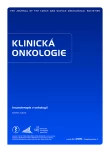Anti‑tumour Weapons of the Immune System
Authors:
V. Hořejší
Authors‘ workplace:
Ústav molekulární genetiky AV ČR, v. v. i.
Published in:
Klin Onkol 2015; 28(Supplementum 4): 15-22
Category:
Generals
doi:
https://doi.org/10.14735/amko20154S15
Overview
Background:
Immune system is principally capable to recognize and eliminate tumor cells, using several mechanisms (phagocytes, antibodies, NK-cells, cytotoxic T‑lymphocytes). These immune weapons are usually not sufficiently efficient as tumor cells are mostly evaluated by the immune system as too similar to normal cells and the tumor microenvironment is very immunosuppressive.
Conclusion:
Recent marked progress in elucidation of mechanisms underlying the relationships between the immune system and tumor cells made it possible to develop a number of very promising immunotherapeutic approaches, including monoclonal antibodies recognizing tumor antigens, antibodies blocking T‑ cell inhibitory receptors, bispecific antibody constructs, in vitro expansion and stimulation of tumor specific T‑lymphocytes, chimeric antigenic receptors expressed in T‑ cells or dendritic cell‑based vaccines. Immunotherapy of neoplastic diseases is apparently becoming reality.
Key words:
tumor antigens – immunological surveillance – immunotherapy – monoclonal antibodies – macrophages – lymphocyte activation – NK-cells – T‑lymphocytes regulatory
This study was supported by the grant GACR No. P302-12-G101.
The author declares he has no potential conflicts of interest concerning drugs, products, or services used in the study.
The Editorial Board declares that the manuscript met the ICMJE recommendation for biomedical papers.
Submitted:
27. 7. 2015
Accepted:
25. 8. 2015
Sources
1. Vigneron N. Human tumor antigens and cancer immunotherapy. Biomed Res Int. In press 2015.
2. Klener P, Otahal P, Klener P et al. Immunotherapy approaches in cancer treatment. Curr Pharm Biotechnol 2015; 16(9): 771– 781.
3. Dunn GP, Old LJ, Schreiber RD. The immunobiology of cancer immunosurveillance and immunoediting. Immunity 2004; 21(2): 137– 148.
4. Chanmee T, Ontong P, Konno K et al. Tumor‑associated macrophages as major players in the tumor microenvironment. Cancers (Basel) 2014; 6(3): 1670– 1690. doi: 10.3390/ cancers6031670.
5. Marvel D, Gabrilovich DI. Myeloid derived suppressor cells in the tumor microenvironment: expect the unexpected. J Clin Invest 2015; 125(9): 3356– 3364. doi: 10.1172/ JCI80005.
6. Moretta L, Montaldo E, Vacca P et al. Human natural killer cells: origin, receptors, function, and clinical applications. Int Arch Allergy Immunol 2014; 164(4): 253– 264. doi: 10.1159/ 000365632.
7. Wang W, Erbe AK, Hank JA et al. NK cell‑ mediated antibody‑ dependent cellular cytotoxicity in cancer immunotherapy. Front Immunol 2015; 6: 368. doi: 10.3389/ fimmu.2015.00368.
8. Coulie PG, Van den Eynde BJ, van der Bruggen P et al. Tumour antigens recognized by T lymphocytes: at the core of cancer immunotherapy. Nat Rev Cancer 2014; 14(2): 135– 146. doi: 10.1038/ nrc3670.
9. Nishikawa H, Sakaguchi S. Regulatory T cells in cancer immunotherapy. Curr Opin Immunol 2014; 27: 1– 7. doi: 10.1016/ j.coi.2013.12.005.
10. Li S, Xie Q, Zeng Y et al. A naturally occurring CD8(+)CD122(+) T‑ cell subset as a memory‑like Treg family. Cell Mol Immunol 2014; 11(4): 326– 331. doi: 10.1038/ cmi.2014.25.
11. Vinay DS, Ryan EP, Pawelec G et al. Immune evasion in cancer: mechanistic basis and therapeutic strategies. Semin Cancer Biol. In press 2015.
12. Tsung K, Norton JA. Lessons from Coley‘s toxin. Surg Oncol 2006; 15(1): 25– 28.
13. Ingersoll MA, Albert ML. From infection to immunotherapy: host immune responses to bacteria at the bladder mucosa. Mucosal Immunol 2013; 6(6): 1041– 1053. doi: 10.1038/ mi.2013.72.
14. Adkins I, Fucikova J, Garg AD et al. Physical modalities inducing immunogenic tumor cell death for cancer immunotherapy. Oncoimmunology 2015; 3(12): e968434.
15. De Palma M, Lewis CE. Macrophage regulation of tumor responses to anticancer therapies. Cancer Cell 2013; 23(3): 277– 286. doi: 10.1016/ j.ccr.2013.02.013.
16. Bonapace L, Coissieux MM Wyckoff J et al. Cessation of CCL2 inhibition accelerates breast cancer metastasis by promoting angiogenesis. Nature 2014; 515(7525): 130– 133. doi: 10.1038/ nature13862.
17. Ford CA, Petrova S, Pound JD et al. Oncogenic properties of apoptotic tumor cells in aggressive B cell lymphoma. Curr Biol 2015; 25(5): 577– 588. doi: 10.1016/ j.cub.2014.12.059.
18. Weiner LM, Surana R, Wang S. Monoclonal antibodies: versatile platforms for cancer immunotherapy. Nat Rev Immunol 2010; 10(5): 317– 327. doi: 10.1038/ nri2744.
19. Redman JM, Hill EM, Al Deghaither D et al. Mechanisms of action of therapeutic antibodies for cancer. Mol Immunol 2015; 67(2 Pt A): 25– 45. doi: 10.1016/ j.molimm.2015.04.002.
20. Weiner GJ. Building better monoclonal antibody‑based therapeutics. Nat Rev Cancer 2015; 15(6): 361– 370. doi: 10.1038/ nrc3930.
21. Turnis ME, Andrews LP, Vignali DA. Inhibitory receptors as targets for cancer immunotherapy. Eur J Immunol 2015; 45(7): 1892– 1905. doi: 10.1002/ eji.201344413.
22. Suryadevara CM, Gedeon PC, Sanchez‑ Perez L et al. Are BiTEs the „missing link“ in cancer therapy? Oncoimmunology 2015; 4(6): e1008339.
23. Rosenberg SA, Restifo NP. Adoptive cell transfer as personalized immunotherapy for human cancer. Science 2015; 348(6230): 62– 68. doi: 10.1126/ science.aaa4967.
24. Dotti G, Gottschalk S, Savoldo B et al. Design and development of therapies using chimeric antigen receptor‑ expressing T cells. Immunol Rev 2014; 257(1): 107– 126. doi: 10.1111/ imr.12131.
25. Pol J, Bloy N, Buqué A et al. Trial Watch: Peptide‑based anticancer vaccines. Oncoimmunology 2015; 4(4): e974411.
26. Melero I, Gaudernack G, Gerritsen W et al. Therapeutic vaccines for cancer: an overview of clinical trials. Nat Rev Clin Oncol 2014; 11(9): 509– 524. doi: 10.1038/ nrclinonc.2014.111.
27. Palucka K, Banchereau J. Cancer immunotherapy via dendritic cells. Nat Rev Cancer 2012; 12(4): 265– 277. doi: 10.1038/nrc3258.
Labels
Paediatric clinical oncology Surgery Clinical oncologyArticle was published in
Clinical Oncology

2015 Issue Supplementum 4
Most read in this issue
- Side‑ effects of Modern Immunotherapy and How to Solve Them in the Clinics
- Immunotherapy of Urothelial Carcinoma of the Bladder – from BCG Vaccines to Targeted Therapy
- Escape Strategies of Tumors from Immune Surveillence
- The Concept of Immunogenic Cell Death in Antitumor Immunity
